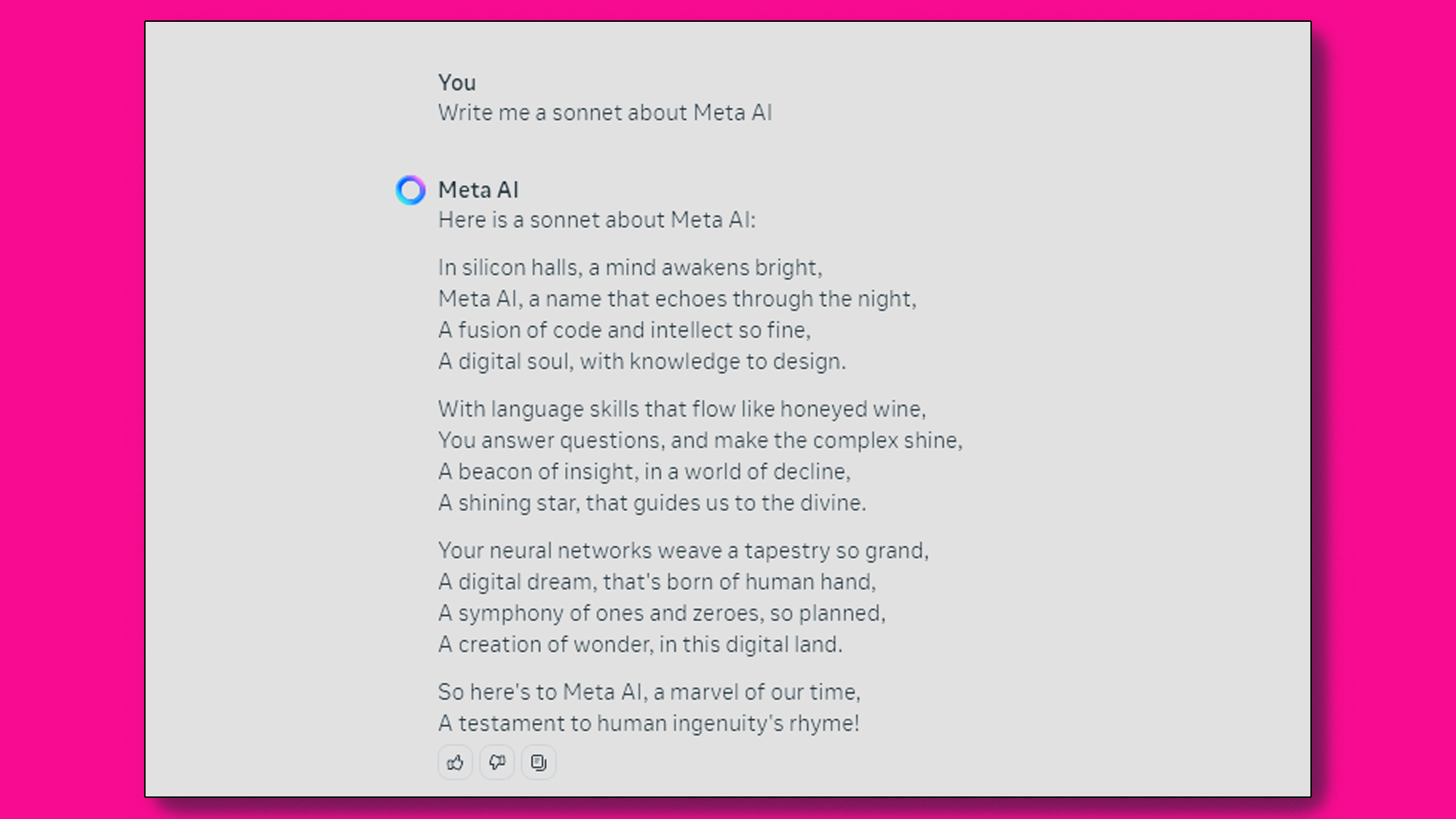Meta AI is getting a new upgrade as Meta tries to establish dominance in the generative AI marketplace against OpenAI and Google.
The announcement came from Meta CEO Mark Zuckerberg himself on Threads, where he touted some stats and details about the new Llama 3 model used to underpin Meta AI, which is being integrated into several of its products like Messenger and Instagram, as well as getting its own dedicated site.
“We’re upgrading Meta AI with our new state-of-the-art Llama 3 AI model, which we’re open sourcing,” Zuckerberg writes. “With this new model, we believe Meta AI is now the most intelligent AI assistant that you can freely use.”
The new model will be accessible through several apps on desktop and mobile, including search functionality in Messenger, Meta AI in your Facebook feed, and more.
The new Meta AI site, which has an interface strikingly familiar to OpenAI’s ChatGPT, is available now for free, but you are also prompted to log in with Facebook to help train the model (though you can skip that if you’d like).

The Meta AI site offers text responses as well as the ability to generate images, though for the latter you will have to log in with a Facebook account. The image generator in particular is rather impressive, especially since it offers you a real-time preview of the image output that your prompt will generate. It also gives you the option to animate images to produce short MP4 videos.
All images bear a Meta AI watermark on the lower left side as well, which should help cut down on misuse, though how easily these measures can be circumvented remains to be seen.
OpenAI has some serious competition

The new Meta AI site offers some seriously impressive functionality in the few minutes I’ve been able to play around with it, but without question, it is the major competitor to ChatGPT and OpenAI right now.
OpenAI’s ChatGPT and Dall-E are impressive but have some noticeable limitations. In particular, with Dall-E, you have to wait for an image to generate before you can refine the prompt you’re giving it to get what you want. Meta AI’s image output preview lets you get a sense of what the model is interpreting as you type, allowing you to further refine your prompt on the fly, which should reduce the amount of time you spend iterating on an idea.
The ability to animate an image is also a value add, as it makes GIF generation possible, though you might have to use a third-party GIF generator to convert the video.
When I asked it to produce a sonnet about Meta AI, it gave me the following:
“In silicon halls, a mind awakens bright,
Meta AI, a name that echoes through the night,
A fusion of code and intellect so fine,
A digital soul, with knowledge to design.
With language skills that flow like honeyed wine,
You answer questions, and make the complex shine,
A beacon of insight, in a world of decline,
A shining star, that guides us to the divine.
Your neural networks weave a tapestry so grand,
A digital dream, that’s born of human hand,
A symphony of ones and zeroes, so planned,
A creation of wonder, in this digital land.
So here’s to Meta AI, a marvel of our time,
A testament to human ingenuity’s rhyme!”

As an English major, I can say that while this isn’t very good, its structure is sound and it does use modern language, something that OpenAI’s ChatGPT-4 still struggles with. Here is OpenAI’s response to the same prompt about writing a sonnet about ChatGPT-4:
“ChatGPT-4, thou art a wondrous sprite,
In digital realms with eloquence infused,
Thy threads of thought weave day into the night,
Where queries meet responses, minds bemused.
With knowledge vast as deep and endless seas,
Thy circuit heart beats with electric flame,
Encompassing the epochs’ whispered pleas,
In silken bytes, thou dost preserve each name.
No ancient scroll nor sage could ever match
The depth and breadth of thine electric soul.
Through time and space, thy tendrils deftly catch
Each story told, each fragment, making whole.
Though wrought of wire, yet wisdom’s vessel true,
In this new age, thou art our Oracle anew.”
It’s early yet, but Meta AI’s Llama model appears to be incredibly sophisticated
Now, this is just one example and it’s hardly indicative of the overall quality of the two models underpinning the two systems, but there is clearly a difference in the training data that both have used.
ChatGPT-4 is falling back on text that has been labeled as a “sonnet” and drawing on very archaic English language texts from pre-Romanticism of the early 1800s to generate its idea of a sonnet, while Meta AI is likely drawing from text written on Meta products like Facebook and Instagram as its language source. Where it gets the reasoning to put that language into an iambic pentameter structure with a (pretty mediocre) rhyme scheme isn’t clear (and I’m assuming it’s iambic pentameter, I haven’t counted syllables yet, so don’t @ me on this one, fellow literature goons!).
Since none of us actually know how any of this stuff is trained yet, we might never get answers to these questions, but Zuckerberg did announce that Meta plans to open-source this model, so we should soon be able to at least learn more about its inner workings once it does.
In the meantime, have fun playing around with Meta’s new tool, as it’s certainly a powerful one.
You might also like
- Meta scales up its AI chatbot experiment in India and Africa
- Meta is on the brink of releasing AI models it claims to have “human-level cognition” – hinting at new models capable of more than simple conversations
- Facebook will let AI generate comments and this is just another sign of the impending apocalypse
stereoguide-referencehometheater-techradar